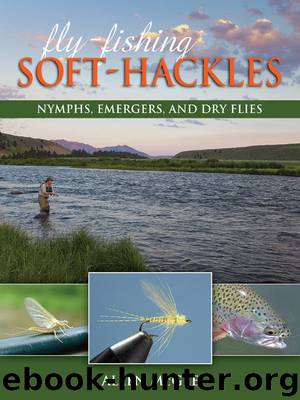Fly-Fishing Soft-Hackles by Allen McGee

Author:Allen McGee
Language: eng
Format: epub
ISBN: 9780811765626
Publisher: Stackpole Books
Grannom (Brachycentrus appalachia, B. occidentalis, B. americanus)
East to West, hatches April through June, and again in the fall (#14-18)
Males are one size smaller than females. Larvae have a chartreuse abdomen and tannish-brown thorax. These casemakers use wood and plant matter. Pupae have the same coloring, and hatches occur midday through late afternoon. Fishing a deep pupa dead drift, or with occasional lifts and drops to animate the soft-hackle collar, in the hours leading up to the surface emergence is important. Fish will feed on the streambed pupae even before they ascend to emerge. Then, fish the pupae from streambed all the way up to the surface, with a smooth swing, rod-tip twitches, short one-to-two-inch strips, or lifted and dropped and lifted until reaching the surface.
Adult bodies have varying appearances. B. appalachia have a newly hatched bright green body, then dark green with a tan thorax. B. occidentalis and B. americanus are dark brownish-olive, with a tan wing. They fly off the water quickly, but trout will still feed on the surface caddis when opportunities exist. Some females dive or crawl underwater to lay eggs, others will drift or skitter on the surface, dropping eggs. After they finish, they drift spent. Once the diving egg layers are finished oviposting underwater, they allow the current to carry them back up to the surface, all the while susceptible to trout, underwater and once on the surface drifting spent. They also sometimes lay eggs on the surface by skittering and dipping their abdomens into the water. Fish the diving egg layer, or apply floatant to the wing for a surface spent egg layer. Subsurface, rod-tip twitches either up and down or left and right will represent egg laying. Also, quick vertical rod-tip lifts will skitter the fly across the surface, especially useful in windy conditions when the wind will blow the line in addition to the rod-tip lifts, resulting in a life-like appearance. Watch the water for signs of skittering egg layers if you see mating flights over the water. If you don’t see surface activity, try fishing a diving or spent egg-laying caddis.
Download
This site does not store any files on its server. We only index and link to content provided by other sites. Please contact the content providers to delete copyright contents if any and email us, we'll remove relevant links or contents immediately.
Backpacker the Complete Guide to Backpacking by Backpacker Magazine(2194)
Capital in the Twenty-First Century by Thomas Piketty(1949)
The Isle of Mull by Terry Marsh(1899)
Predation ID Manual by Kurt Alt(1658)
The Collected Non-Fiction by George Orwell(1574)
Small-Bore Rifles by C. Rodney James(1505)
All Fishermen Are Liars by John Gierach(1447)
Backcountry Bear Basics by Dave Smith(1435)
Creative Confidence by Tom Kelley(1417)
The Art of Throwing by Amante P. Marinas Sr(1357)
50 Famous Firearms You've Got to Own by Rick Hacker(1342)
Blood Mountain by J.T. Warren(1305)
Archery: The Art of Repetition by Simon Needham(1303)
Long Distance Walking in Britain by Damian Hall(1280)
The Scouting Guide to Survival by The Boy Scouts of America(1252)
Backpacker Long Trails by Backpacker Magazine(1249)
The Fair Chase by Philip Dray(1228)
The Real Wolf by Ted B. Lyon & Will N. Graves(1214)
The Ultimate Guide to Home Butchering by Monte Burch(1205)
